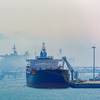ABS to Class ChevronTexaco Truss Spar
ABS will class the ChevronTexaco “Tahiti” truss spar, destined for deepwater Gulf of Mexico. Targeted for 4,200 feet of water, the “Tahiti” unit demonstrates the industry’s latest innovations—including the first spar with no drilling capability, no surface wellheads—and is among the first spar projects to utilize ABS’ industry-first guide for building and classing these specialized deepwater floating production units, says Dick Vukin, ABS project manager.
ABS reissued its “Guide for Building and Classing Floating Production Installations” (FPI) in April 2004 to include specific guidance for spars and tension leg platforms (TLPs).
“By applying the evaluation techniques contained within the Guide, together with future class surveys, ABS offers clients the most advanced approach to the evaluation of structural integrity and reduced operational risk,” said Vukin.
Developed in response to emerging technological advances in spar and TLP design, Vukin explains that the update incorporates ABS’ extensive experience in classing these units while emphasizing the global performance issues and motion characteristics unique to these floating structures.
This “Tahiti” contract marks the industry’s fifteenth spar, with ABS having classed 14 of the units. ABS will class the “Tahiti” unit as an A1 Floating Offshore Installation (FOI). FOIs include spars, semisubmersibles and TLPs, in addition to ship-type process and storage facilities.
Classification will cover the “Tahiti” unit’s hull, mooring systems, topsides, power generation, platform layout and all marine, utility and safety systems, including life-saving equipment and fire-fighting appliances. The classification will not include the hydrocarbon production facilities. ABS also will act on behalf of the U.S. Coast Guard and as a Certification Verification Agent (CVA) for the U.S. Minerals Management Service. CVA review and approval for “Tahiti” will include structural design, fabrication and installation. “Tahiti,” planned for Green Canyon Blocks 640, 641 and 596, marks ChevronTexaco’s second ABS-classed FOI for Gulf of Mexico installation. The first was ChevronTexaco’s “Typhoon” TLP, installed in 2001. The oil major also operates the “Genesis” spar, installed in the Gulf of Mexico in 1998. “Tahiti” will be the thirty-second FOI in the U.S. offshore industry, with ABS having classed 24 of the units. The remaining eight FOI units—including “Genesis”—currently are not classed; however, ABS has completed CVA evaluations of the structural design of each unit. There are presently some 20 TLPs and some 15 spars installed worldwide, with an estimated 20 new TLPs and another 30 spars expected over the next decade, making the ABS FPI Guide a valuable tool for facilitating marine safety for these units industry-wide, says Vukin. “In classing “Tahiti” and other FOIs using the newly updated Guide, ABS offers clients an effective approach to the life cycle evaluation and maintenance of the unit,” he adds. ABS is presently working closely with the ChevronTexaco “Tahiti” project team during the front-end engineering phase to smooth and speed the approval process. While the FPI Guide addresses column-stabilized units and other types of floaters, key areas of emphasis in the latest edition include global performance requirements, load and environmental issues, stability parameters and structural strength criteria for spars and TLPs. The Guide requires that owners of these units perform global performance analyses to fully address the comprehensive effects of environmental loads on an overall platform and its components, including the deck, hull, tendons, mooring system and risers, advises Vukin. “By ‘codifying’ these impacts, we’re able to offer a more time-efficient design review for a deepwater floater, such as ChevronTexaco’s ‘Tahiti’ truss spar.” The new Guide requires that all emergency and safety systems, including life saving and abandonment equipment, are to be operational at parameters specified for storm survival and specific wind conditions. The detailed parameters define wind speed and list angle limits for varying operational scenarios. Load issues addressed in the Guide include: environmental loads, hydrostatic pressures and buoyancy, gravity and inclination-induced loads, inertia loads, operational loads, mooring and riser loads, marine operation loads, vortex-induced vibration (VIV) loads during both transportation and operation and site-specific storm design levels. “VIV loads are new to the Guide and are particularly important to the safe operation of spars,” said Vukin. He adds that VIV loads and fatigue strength are to be fully assessed and the mooring system fully analyzed, considering VIV effects. New requirements in the Guide address modules and topside buildings, such that the design of these components is consistent with the overall structural analysis. “Structural verification of topsides modules and buildings will promote overall safety on these deepwater installations,” said Vukin. “We hope that our technical insight and flexibility for encouraging continued deepwater innovation will benefit ChevronTexaco, and all of our customers, in their pursuit of frontier development,” said Vukin. Founded in 1862, ABS is a leading international classification society devoted to promoting the security of life, property and the marine environment through the development and verification of standards for the design, construction and operational maintenance of marine-related facilities.










